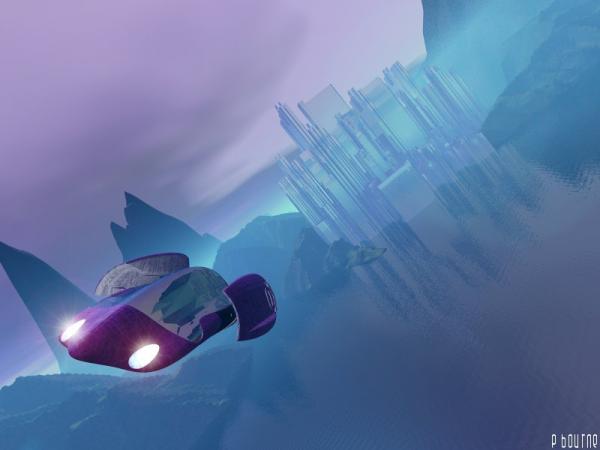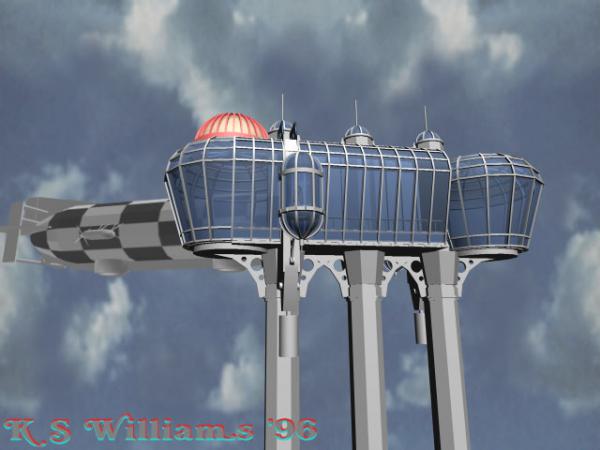BY LETTER
Atmospheric Transport
Atmospheric transportation refers to vehicles and devices of various sorts for travel through gases, either in a planetary atmosphere or in the air of a large hab or worldhouse.
Articles
- Aerospace Engineering - Text by M. Alan Kazlev, modified from the original write-up by Robert J. Hall
A field of engineering that combines aerodynamics, fluid dynamics, propulsion, thermodynamics, aerospace mechanics, virch simulations, materials science, energy use, nanofabrication and vehicular structures. - Aircar - Text by Todd Drashner
Small personal aircraft often used for short to medium range transportation on planetary surfaces or within habitats and megastructures. - Aircraft - Text by M. Alan Kazlev
Any vehicle capable of atmospheric travel at higher than ground-effect level. - Atlantean Airship - Text by Thorbørn Steen
A popular air vehicle used by the inhabitants of Atlantia on Corona. - Bubblehabs - Text by Stephen Inniss, With additional material by Tardigrada 2021
Artificial habitats that float in a planetary atmosphere, such as a cytherian, neptunian or jovian world. - Dirigible - Text by Stephen Inniss
A neutrally buoyant atmospheric vehicle that is distinguished from other aerostats such as balloons by the fact that it can be steered and propelled. Dirigibles have remained a feature life on planets or in the larger habitats such as Bishop rings or Banks orbitals ever since the gas giants of Solsys were colonized in the Interplanetary Age. Fixed-wing craft are still preferred for rapid transport, but dirigibles of one kind or another are ubiquitous as automated cargo carriers and are also popular as leisure craft. - Eaglenet - Text by Jorge Ditchkenberg
A recreational device allowing unaugmented hu, and other clades, to fly like a bird. - Exoatmospheric Fighter - Text by M. Alan Kazlev
A small planet- ship- or orbital- based hybrid air- and space-craft, usually short- to very short range and armed with lasers and automatic cannon. Crew may include one or two bionts and several dedicated ai, or the whole vessel may be ai controlled. Propulsion is via jet or nanobank turbine for dense or slow atmospheric flight, ramjet or scramjet for hypersonic flight, and chemical, fusion or amat rocket for vacuum propulsion. - Fan Matrix - Text by Johnny Yesterday
Mesoscale fan array. - Fancloth - Text by Terrafamilia
Material which uses microscale engineering to allow flight. - Laser-launched surface-to-orbit craft - Text by Anders Sandberg
Laser launch systems - Lifts, The (Kiyoshi) - Text by Todd Drashner
System of artificial airborne 'islands' built on Kiyoshi to commemorate the bimillenial of its construction. - Lurkship - Text by M. Alan Kazlev
Generally, a heavily armed and armoured, short-range hyperturing military vessel, capable of stealth operations in a hydrospheric and atmospheric environment for greatly extended periods of time. Subcraft or subships are similar but smaller and less well armed and equipped. - Omnicraft - Text by Todd Drashner
Versatile mode of transport designed to operate and provide accommodations in a wide range of environments from planetary surfaces to interplanetary space. - Personal Transport Technology - Text by Terrafamilia, Ryan B (wing pack)
Some modes of personal transport that became possible during the Solsys Golden Age. - Subcraft, Subship - Text by M. Alan Kazlev and Michael Beck
Triphibious manned extended mission stealth-capable gunship. - Tohulian Skyships - Text by Evil DoDo
Floating vessels constructed on Tohul Prime. - Vacuum Dirigibles - Text by Todd Drashner with additions by Steve Bowers
Lighter-than-air flying machine built around the use of nanotech constructed materials. - Wingpack - Text by Todd Drashner
Personal transportation device that allows bird-like flight.
Related Topics
| Atmospheric Weapons | Interplanetary Transport | Interstellar Transport |
| Liquid Transport | Propulsion Technology | Ships |
| Subsurface Transport | Surface Transport | Surface-To-Orbit Transport |
| Transportation |
Development Notes
Text by Stephen Inniss
Initially published on 28 February 2009.
Initially published on 28 February 2009.
Additional Information








